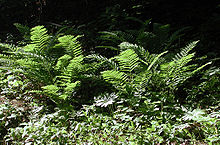Claytosmunda
| Interrupted fern | |
|---|---|

| |
| Typical fertile fronds | |
| Scientific classification | |
| Kingdom: | |
| Division: | |
| Class: | |
| Order: | |
| Family: | |
| Genus: | |
| Species: | O. claytoniana
|
| Binomial name | |
| Osmunda claytoniana | |
Osmunda claytoniana (interrupted fern) is a fern native to eastern North America and eastern Asia. In eastern North America it occurs from southern Manitoba, Ontario, Quebec (up to the tree line), east to Newfoundland and south through the Appalachian mountains down to Georgia and west to the Mississippi River. In Asia, it is found in the Himalaya, southern China, Japan, Korea, and Taiwan. Fragmentary foliage resembling O. claytoniana has been found in the fossil record as far back as the Triassic, and is known as Osmunda claytoniites
It is named after the English-born Virginian botanist John Clayton.[1]
The fronds are bipinnate, 40-100 cm tall and 20-30 cm broad, the blade formed of alternate segments forming an arching blade tightening to a pointed end. The lower end is also slightly thinner than the rest of the frond because the first segments are shorter. Three to seven short, cinnamon-colored fertile segments are inserted in the middle of the length, giving the plant its name. In their absence, the plant in all its stages appears similar to Osmundastrum cinnamomeum (Cinnamon Fern). To distinguish them, look at the base of the segments; where O. cinnamomeum has typical felt-like hairs, the few hairs present on O. claytoniana are extremely short, usually requiring a magnifying glass to see well.
Like other species in the family Osmundaceae, it grows a very large rhizome, with persistent stipe bases from previous years. It forms small, dense colonies, spreading locally through its rhizome, and often forming fairy rings.

Ecological aspects
It is found in humid zones, mostly in forests, but also in more open biomes, although rarely in bogs. The interrupted fern is often found alongside ostrich, cinnamon and sensitive ferns.
The plant is known from fossils to have grown in Europe, showing a previous circumboreal distribution.
Osmunda × ruggii, a hybrid between O. claytoniana and O. regalis (Royal Fern), is the only known hybrid in the family Osmundaceae. The hybrid is considered important because it suggests a closer genetic relationship between O. claytoniana and O. regalis than between O. claytoniana and O. cinnamomeum (a fact which has led to moving O. cinnamomeum out of Osmunda and into its own genus Osmundastrum). Osmunda × ruggii is sterile and is known from only about two natural populations, despite the many areas in which both O. claytoniana and O. regalis are found.[2]
Cultivation and uses
Unlike those of the ostrich fern, the interrupted fern's fiddleheads are not readily edible, due to their bitter taste and a tendency to cause diarrhea. The base of the stipe and very young buds are edible, but should not be abused for risk of killing the crown.
References
- ^ Fernald's "Gray's Manual of Botany" (1950)
- ^ "4. Osmunda ruggii R. M. Tryon".
{{cite web}}: CS1 maint: postscript (link)
- Flora of North America: Osmunda claytoniana RangeMap:
- Flora of Taiwan: Osmunda claytoniana
- Lamoureux, Gisèle and al. (1993). Fougères, prêles et lycopodes. Fleurbec. ISBN 2-920174-13-4.
- Phipps, C.J., Taylor, T.N., Taylor, E.L., Cuneo, N.R., Boucher, L.D., and Yao, X. (1998). Osmunda (Osmundaceae) from the Triassic of Antarctica: An example of evolutionary stasis. American Journal of Botany 85: 888-895
